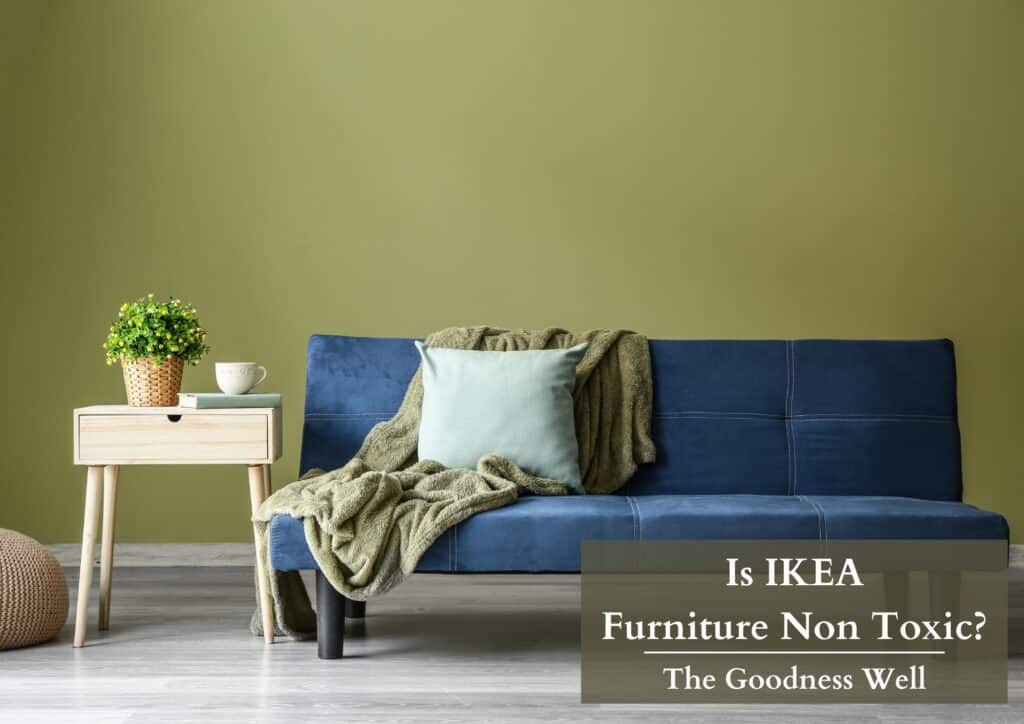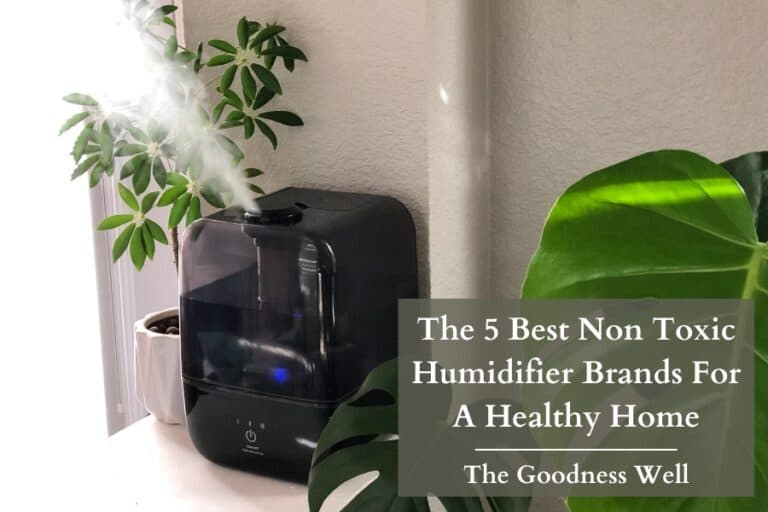Is IKEA Furniture Non-Toxic? Here’s The Truth

Like other large furniture stores such as Ashley’s furniture (which we also do a deep dive into), IKEA is one of the biggest retailers out there.
I’m sure you can already picture their labyrinth-like store guiding you around with its conveniently placed arrows.
It’s affordable, convenient, stylish, and trendy but ask yourself “Is IKEA furniture non toxic?
So to help you get to the bottom of this question we dug into the details to discover the truth.
TL;DR
Is IKEA furniture non toxic?
No. IKEA furniture is toxic because of the engineered wood (particleboard, fiberboard, and plywood) and synthetic materials like polyester and melamine foil that off-gas toxic VOCs(Volatile Organic Compounds) like formaldehyde that are linked to serious health effects. IKEA is also considered a fast furniture company that mass produces affordable cheaply made furniture not built to last which in the end contributes to landfill waste, polluted waterways, and microplastics ending up in plant and animal life.
What makes IKEA Furniture Toxic?
Ok, so we did A LOT of research to get to the bottom of this.
IKEA has “consumer health friendly” and “sustainable” sounding verbiage on their website but let’s get into what we found.
First, let’s look at two examples of IKEA’s “Top seller” products.
Example #1: The Billy Bookcase by IKEA

Right away looking at this product, you can see it’s made using engineered wood like particleboard and fiberboard.
The problem is that each of these materials is heavily processed and has the potential to off-gas toxic chemicals.
Not to mention, they are nowhere near as durable as solid wood which means they won’t last as long, meaning you’ll be replacing this bookshelf sooner than you should have to.
Engineered wood like fiberboard and particleboard are made with glues that contain formaldehyde and other VOCs.
Now although formaldehyde does exist naturally within the environment, creating additional exposure from glues and adhesives can cause health issues including irritation of the skin, throat, lungs, and eyes and, in long-term exposure, cancer.
IKEA’s Shift In Formaldyhde Use
Formaldehyde use at high levels was actually a really big issue with IKEA products that went unchecked until 1992.
In 1992, IKEA was hit with public outrage and concern when a German investigative reporter found high levels of formaldehyde in their Billy Bookcase.
After this, IKEA was forced to reconsider their products and how they could be made safer. While they did make changes in restricting many harmful chemicals in their products there are still certain ones still being used including VOCs like formaldehyde.
While IKEA seems to be transparent with a lot of the materials and chemicals used, they still leave a lot up for consumers to question and investigate.

Above is a snippet of how formaldehyde is listed on the IKEA Restricted Substance List(be mindful that the substances on this list are not restricted from being completely used just restricted at certain levels).
Formaldehyde is restricted at 100ppm “(unless otherwise stated)” but according to the OSHA Fact Sheet, formaldehyde at 100ppm is already “dangerous to life”. YIKES…😳
Lastly, more commonly used in cooking utensils melamine foil is another material that can off-gas, exposing you to harmful chemicals like formaldehyde and other VOCs.
Example # 2: The Morabo Sofa by IKEA

Now that we’ve already discussed the issue with engineered wood like particleboard, fiberboard, and plywood, let’s take a look at the synthetic fabric and foam being used in this product.
Two of the most common synthetic materials I see being used in toxic furniture are polyester and polyfoam(polyurethane foam).
Polyfoam/Polyurethane Foam
Polyurethane foam is used in mattresses and cushions in couches to give it the bouncy, comfortable feeling we all love.
However, the production of polyfoam can be very toxic, especially during the manufacturing phase. Polyfoam has the potential to release VOCs into the air.
What makes this specific use of polyurethane concerning is that there are no third-party certifications to ensure safe emission limits.
Certi-Pur would be good to see but GreenGuard Gold or GOLS (Global Organic Latex Standard) would be the best certification to see for this product, but none of these are present. 🫠
Polyester And The Effects Of Microplastics
Polyester is a synthetic fabric that has been linked to reproductive issues including lower sperm count and endocrine disruption.
Because it’s a type of plastic, microplastics can break from it and enter into the air, and even your body.
Not to mention, when polyester is washed microplastics have the potential to end up in the environment, causing devastating effects.
For example, let’s say you take a polyester couch cushion cover and wash it. The water used from the washing machine to wash the polyester cover is polluted by microplastics during the wash cycle.
That same water can end up in waterways and soil.
Water polluted with microplastics from polyester fiber can change the overall organic structure of the soil.
After that microplastics found in soil can enter into crops and plant life finding its way into our bodies. Microplastics that enter into waterways like oceans and rivers can end up being consumed by animals.
If those animals are eaten by us, then you guessed it, those microplastics also end up in us.

Microplastics are EXTREMELY hard to break down and can take decades and even centuries. While the effects of microplastics are still being studied, it has been linked to increased risk for colorectal cancer.
Other Reasons Why IKEA Is Not Non Toxic
The history of IKEA hasn’t always been as polished and clean as its store.
In fact, in the early 1990’s there were some pretty serious claims about large furniture chains using child labor to make their products.
Turns out this was true.
In 1994 a Swedish documentary proved that IKEA was using child labor to produce some of their products.
Once this came out, IKEA acted quickly to break ties with the Pakistani rug industry that employed child labor. And in 2000 IKEA created their code of conduct to combat child labour.
The other reason we don’t consider IKEA to be nontoxic is because of how unsustainable their products are.
Not only does this mass production of cheaply made furniture contribute to the 12 million tons of fast furniture pollution we see every year, but it also adds to the microplastics and chemicals leaking into waterways, the air, crops, and eventually our bodies.
IKEA Restricted Substance List
So we’ve talked about a few of the substances on the IKEA Restricted Substance List but I want you to understand how to read it.
Remember just because it’s on the list doesn’t mean it’s not in their products. It’s just restricted.
And just because it’s restricted at a certain level does not mean that level is safe.
Keep an eye out for phrases like “is only allowed to be used with approval from IKEA.”. You’ll see that a lot. IKEA giving IKEA the green light to use “Restricted Substances” from the IKEA Restricted Substances List. 🧐
Does IKEA Furniture Have Non Toxic Certifications?
I couldn’t find any of the normal certifications we look for in nontoxic products like GreenGuard Gold GOTS (Global Organic Textile Standard) and GOLS (Global Organic Latex Standard.
But I did find FSC (Forest Stewardship Council).
FSC is a third-party certification that ensures wood used in a product is sourced sustainably from ethically managed forests.
This an awesome certification to have so, great job IKEA.
However, this doesn’t mean that wood isn’t then treated with toxic chemicals and treatments to be used in their products. And concluding from the lack of non-toxic certifications, that’s exactly what happens…
Final Thoughts
So no…IKEA is not a non toxic brand. Although they’ve made steps in the right direction whether that was out of concern for consumer health or to protect their reputation, they still have a way to go.
But don’t be discouraged there are so many furniture brands doing it way better than IKEA by providing consumers with genuinely certified and non toxic furniture!
FAQ
Although IKEA has made progress in restricting formaldehyde limits, many of the engineered wood products still contain formaldehyde.
IKEA cribs can contain VOCs and since babies are more sensitive to formaldehyde, it’s best to choose non-toxic cribs.
Most likely your new furniture is off-gassing some amount of VOC content. This is not uncommon when you first unwrap your furniture but this can cause problems with your indoor air quality.
IKEA has made great progress in limiting the amount of toxins in their furniture. However, some amounts of toxic chemicals like formaldehyde, VOCs, phthalates, and flame retardants remain.
Because IKEA furniture does still contain harmful chemicals, it’s best to choose safer non toxic nursery brands.
There is no direct link between IKEA furniture use to cancer. However, some of the chemicals like formaldehyde found in IKEA furniture are known carcinogens.






